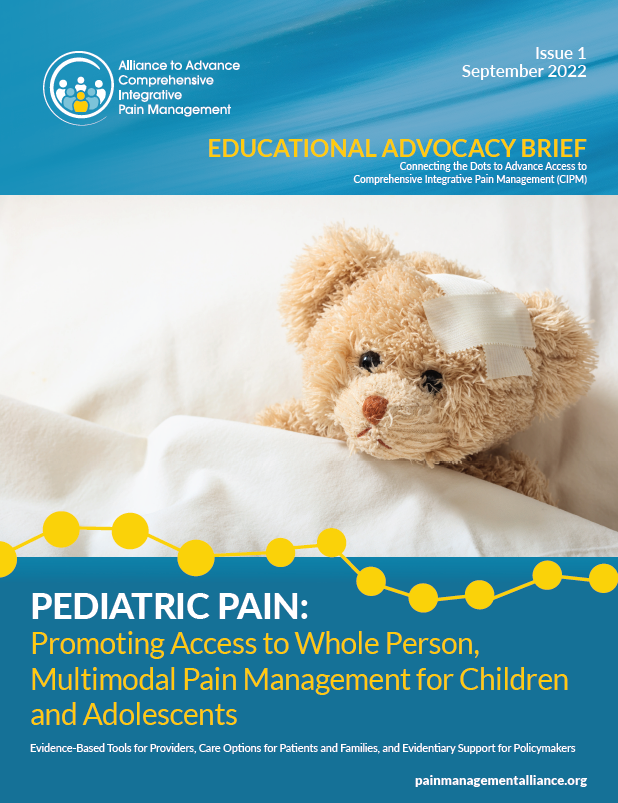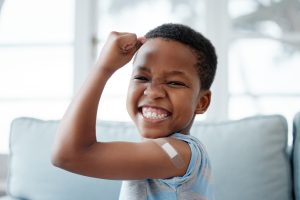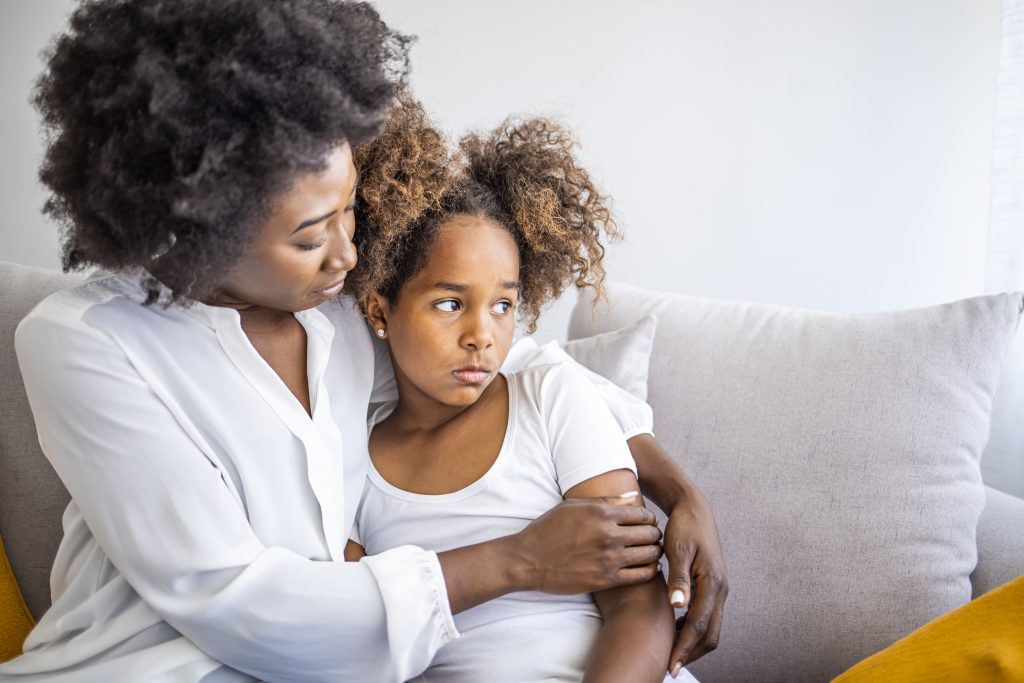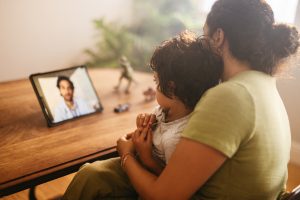 Connecting the Dots to Advance Access to Comprehensive Integrative Pain Management (CIPM)
Connecting the Dots to Advance Access to Comprehensive Integrative Pain Management (CIPM)
Pediatric Pain: Promoting Access to Whole Person, Multimodal Pain Management for Children and Adolescents
Evidence-Based Tools for Providers, Care Options for Patients and Families, and Evidentiary Support for Policymakers
Our Youth are Hurting:
Reconsidering How We Treat and Prevent Children Living with Pain
Children are living through extraordinarily difficult times. For over two years, the COVID-19 pandemic has resulted in countless families facing financial insecurity, food scarcity, a highly dangerous contagion, the tragic and premature deaths of loved ones, and the emerging fallout of long-COVID. Rates of severe depression and suicide in our nation’s youth have skyrocketed, spurring leading pediatric groups to declare a national emergency in children’s mental health.1,2
Chronic pain is an undertreated, underrecognized, and misunderstood condition affecting one in four children and adolescents worldwide.3 Further, the prevalence of chronic pain in young people is increasing overall, as is the prevalence of high impact chronic pain in children and adolescents.4,5,6 Exacerbating their plight, children and teens ages 0-17 are a vulnerable population in need of special attention with regard to pain management given their dependency upon adults with regard to pain assessment, prevention, and treatment.7 What’s more, children are more likely than adults to avoid or feel reluctant to talk about pain they are experiencing that could alert care providers to the presence and severity of their pain.
 There is a well-established link between mental health and chronic pain. Untreated pain has been shown to worsen depression, and depression often worsens pain.8 Moreover, multiple studies have shown that adverse childhood experiences (ACEs) often result in negative health effects in later life, including a much greater risk of developing chronic pain.9 Most individuals have experienced at least one ACE (57.8%) with 21.5% experiencing 3+ ACEs.10 While ACEs are typically defined to include physical and sexual abuse, neglect, humiliation, and parental separation, or incarceration, ACEs may also encompass other undefined negative conditions or experiences occurring during childhood—which may well include a life-altering pandemic, particularly when associated with specific negative consequences.
There is a well-established link between mental health and chronic pain. Untreated pain has been shown to worsen depression, and depression often worsens pain.8 Moreover, multiple studies have shown that adverse childhood experiences (ACEs) often result in negative health effects in later life, including a much greater risk of developing chronic pain.9 Most individuals have experienced at least one ACE (57.8%) with 21.5% experiencing 3+ ACEs.10 While ACEs are typically defined to include physical and sexual abuse, neglect, humiliation, and parental separation, or incarceration, ACEs may also encompass other undefined negative conditions or experiences occurring during childhood—which may well include a life-altering pandemic, particularly when associated with specific negative consequences.
Undertreated childhood pain can lead to lifelong health issues and financial burdens. Long-term exposure to severe pain without adequate treatment has negative long-term consequences, including increased morbidity and mortality, predisposing undertreated young people to lifelong harms. Further, the long-term effects of ACEs have been shown to have long-term effects on development, negative adult psychological and physical health outcomes, risky health behaviors, healthcare utilization, and associated high societal and familial financial burdens.11 What’s more, the early introduction of opioids in childhood can lead to the development of opioid use disorders in adulthood.12However, research has shown that factors associated with the development of chronic pain and related disability are modifiable, meaning it is imperative that we treat children early to help them avoid negative lifelong consequences.13
Support for a Whole Health Approach to Treating Children and Adolescents with Pain
Leading authorities agree that treating pain in children and adolescents is best accomplished through a Whole Health approach to comprehensive integrative pain management (CIPM).14,15,16 Considered a global health priority, the World Health Organization recommends that countries prioritize appropriate pain management for children, advocating for policies and regulations which encourage the use of multidisciplinary teams and both pharmacological and non-pharmacological approaches to managing pain. According to the American Academy of Pediatrics, an organization of 67,000 pediatricians within the United States, an increasing number of pediatricians are offering complementary and integrative therapies as part of their medical practice, with many having completed a fellowship in integrative medicine or certification through the American Board of Integrative Holistic Medicine or the American Board of Integrative Medicine.
What does a CIPM care plan look like?
High-quality CIPM is person-centered and focuses on maximizing function and wellness. Care plans are developed through shared decision-making that takes into account the available evidence regarding optimal clinical practice and each patient’s goals and values—and in the case of children, the goals and values of their parents and/or caregivers. Pediatric pain care models that embrace CIPM aim to meet the physical, psychological, social, vocational, and spiritual needs of children and their families.
How do parents and families feel about CIPM for their children?
Demand for increased access to pediatric CIPM is high among parents and caregivers of children with chronic pain, but this type of care is difficult to access. In 2021, a staggering 65% of surveyed families with a child living with chronic pain were unable to find a provider who is knowledgeable about their child’s condition, and nearly 40% of those surveyed would like for their child to be seen by a pain specialist but have been unable to do so due to lack of coverage for multidisciplinary treatment options, lack of local pain specialists, and other barriers to care.17,18 When these families were asked to list the types of therapy or medications they’d like more information about, the most commonly requested information centered on integrative medicine and services, pediatric pain management care, and mental health care—the hallmarks of a high-quality CIPM model of care.
Where can parents and caregivers access CIPM for their children?
How can this access be expanded?
Parents and Caregivers, health care providers, employers providing health insurance, payers, researchers, hospital and clinic administrators, and governmental policymakers can all take part in increasing children’s access to high-quality integrative pain management options. For ways that you can help children living with pain to access high-quality CIPM, see below for patient and caregiver resources, clinical models of care, resources to reduce disparities, key evidence in support of CIPM, educational opportunities, policy toolkits, and more.
Resources
 The following section contains resources, toolkits, directories, and more related to:
The following section contains resources, toolkits, directories, and more related to:
- Support for Children and Families
- Examples of CIPM Models of Care and Policy Initiatives that Support Whole Health for Pediatric Pain
- Educational Modules and Support for Incorporating CIPM for Pediatric Pain into Practice
- Employers Supporting CIPM and Family-Friendly Policies
- Research Supporting CIPM in Pediatric Populations
- Research Supporting Single Modalities Commonly Used as a Component of CIPM in Pediatric Populations
Please note, it is our hope that these resources will continue to grow and evolve. In the spirit of collaboration and inclusivity, we ask that you send us any relevant resources that you believe would be helpful to others so that we may add them over time.
Support for Children and Families
- Pediatric Pain Clinics 2022, a listing of pediatric pain clinics in the United States, Canada, Spain, Belgium, Germany, Hungary, Ireland, Israel, Netherlands, Switzerland, Australia, New Zealand, and the United Kingdom. Listings include information on the types of professionals and services offered by each program, along with the age of patients accepted and the languages that services are offered in.
- Children and the Use of Complementary Health Approaches, NCCIH. A webpage aimed at providing parents and caregivers information about the use of various complementary health approaches in children, their safety and effectiveness, important considerations, and selecting a care provider.
- Well Being Trust’s Resources for Youth and Young Adults, a listing of online mental health resources and advocacy information aimed specifically at youth and young adults, including teen-to-teen helplines, resources for parents of teens, suicide prevention and crisis intervention information, and more.
- Creative Healing for Youth in Pain, an online community that offers resources, support groups, and strategies for teens and families living with chronic pain.
- Pediatric Pain Warriors, a program that assists children and their families in finding a support, resources, and community. This program offers in-depth retreats and events, featuring expert speakers, workshops, and more.
- Pain Management for Kids! An online resource from the Hemophilia Federation of America, this toolkit provides parents and caregivers with webinars related to tackling pain and anxiety, coping techniques, learning to recognize and treat pain appropriately, lists of helpful Apps for pain management, comfort and distraction tips, and more.
- Complementary and Integrative Medicine: What Parents Need to Know, is an article from the American Academy of Pediatrics that explains what common terms mean, whether certain products are regulated by the FDA, how care providers are licensed and/or trained, care insurance may cover, and more.
- Little Kidz Foundation. Provides support, education, and program development to families, healthcare professionals, and hospitals. Offers a Certified Infant Massage Teacher course designed for parents and caregivers without a healthcare background.
- PainBytes, a website containing a series of seven episodes designed to help youth develop skills and strategies in pain self-management.
- MOMENTS Support Group, designed for caregivers of children with complex medical conditions, provides a safe, nurturing and supportive community for the many defining moments one experiences while caring for a child who needs medical care. Caregivers have opportunities to connect through workshops, speakers and other educational opportunities. Meetings are virtual, the second Thursday of each month at 6:00pm. ET.
 Examples of CIPM Models of Care and Policy Initiatives that Support and Whole Health for Pediatric Pain
Examples of CIPM Models of Care and Policy Initiatives that Support and Whole Health for Pediatric Pain
- Pediatric Pain Clinics 2022, a listing of pediatric pain clinics in the United States, the UK, and eleven other nations. Not all models are fully integrated, but listings include information on the types of professionals and services offered by each program and can serve as a helpful guide to locating CIPM programs.
- Integrated Care for Kids Model (InCK), CMS Innovation Center, is a local service delivery and state payment model that aims to reduce expenditures and improve the quality of care for children covered by Medicaid through prevention, early identification, and treatment of behavioral and physical health needs. Some programs also include Children’s Health Insurance Program (CHIP) beneficiaries and pregnant woman over age 21 who are covered by Medicaid.
- WholeHealthED, the Project for Whole Health Learning in K-12, advocates for incorporating comprehensive whole health studies in American formal education by unifying activities shown to strengthen student well-being: the school garden, nature education, nutrition and teaching kitchen, mindfulness and yoga and cognition-supporting physical activities. Their health supporting outcomes help mitigate the impact and associated pain of adverse experiences, trauma, and negative social determinants, and they reinforce the goals for social and emotional learning (SEL).
- Medicaid 1115 Waivers in Massachusetts and Oregon. In MA and OR, CMS has approved demonstration initiatives to test improvements in coverage, access, and quality with innovative approaches to ensure more eligible people retain their Medicaid coverage. The initiatives also address unmet health-related social needs, such as by giving the states new authority to test coverage for evidenced-based nutritional assistance and medically tailored meals, clinically-tailored housing supports, and other interventions.
Examples of Specific Programs
The Whole Child Center, a New Jersey clinic dedicated to providing children and families with high-quality, state-of-the-art integrative medical care. Offers yoga, infant massage, mind-body medicine, nutritional counseling, aromatherapy, Western and Chinese medicine, and homeopathy.
Whole Child LA (WCLA), a Los Angeles clinic reducing healthcare disparities and providing expert, integrative diagnosis and treatment to children and young adults with pain who have not had relief from their primary care providers and other specialists.
Comprehensive Pain Management Center at University of Michigan C.S. Mott Children’s Hospital, helping children, adolescents and young adults to deal with ongoing pain and aiming to return them to normal, healthy activities of daily living. In addition to medical treatment, the program provides services and supports related to nutrition, palliative care, massage, psychology and social work, support groups, schooling, interpreters, grief assistance, spiritual care, and more.
The Children’s Integrative Therapy Pain Management and Supportive Care (CHIPS) Program at Hasbro Children’s Hospital provides comfort and support, as well as pain and symptom management for children with serious or chronic illnesses. Their goal is to help meet the physical, emotional and spiritual needs of these children with life-limiting illnesses and their families through a family-centered approach and multidisciplinary care.
Boston Children’s Hospital Program for Complex Regional Pain Syndrome in Children combines services from BCH’s Pain Treatment Center, Pediatric Pain Rehabilitation Center, Performing Artist Athletes Program, Chronic Pain Clinic, and The Comfort Ability Program.
 Educational Modules and Support for Incorporating CIPM for Pediatric Pain into Practice
Educational Modules and Support for Incorporating CIPM for Pediatric Pain into Practice
- Academy of Pediatric Integrative Medicine. The mission of APIM is to expand knowledge about treatment options and emerging research in the emerging field of pediatric integrative medicine. The Academy is inclusive, CME driven, evidence-based, and focuses on collaborative learning through dynamic courses.
- Society for Pediatric Pain Medicine. SPPM aims to provide a home for all clinicians involved in pediatric pain related research, or in the delivery of care for children with acute, chronic, cancer pain or regional analgesia. The Society offers education including case reports, books for clinicians, an Interdisciplinary Chronic Pain Treatment special interest group, and more.
- Pediatric Pain Management Toolkit, Innovation and Improvement Center, Emergency Medical Services for Children. This tool box provides key resources and information for the emergency care provider to better understand, assess, and relieve children’s pain in the prehospital and emergency department settings.
- Nonpharmacologic Toolkit, Pain Assessment and Management Initiative. The PAMI® Nonpharmacologic and Distraction Toolkit focuses on nonpharmacologic pain management. The free, downloadable toolkit includes topics such as a stepwise approach to pain management that incorporates pharmacologic and nonpharmacologic measures, therapeutic language, comfort positioning, coaching, distraction, guided imagery and other physical/psychosocial modalities.
- Section on Integrative Medicine (SOIM), American Academy of Pediatrics. AAP’s Section (or, special interest group) on Integrative Medicine focuses on educational and policy strategies to advocate for research on complementary and alternative therapies used in pediatrics.
- Special Interest Group on Pain in Childhood, International Association for the Study of Pain. The objectives of this SIG are to: promote education about pain in children; share relevant information about children’s pain control; advance our ability to alleviate children’s pain from an international and interdisciplinary perspective; and, encourage research, particularly multicenter studies, and studies which focus on unique problems of pediatrics, including newborns.
- Pain Management in Infants, Children, Adolescents, and Individuals with Special Health Care Needs, American Academy of Pediatric Dentistry. Recognizing that infants, children, adolescents, and individuals with special health care needs can and do experience pain due to dental/orofacial injury, infection, and dental procedures, and that inadequate pain management may have significant physical and psychological consequences for the patient, the AAPD has encourage professionals to use non-pharmacologic and pharmacologic strategies to reduce pain pre-operatively and suggests considering non-opioid analgesics as first line agents.
- Pediatric Pain Management, CNE. Providing 1.4 contact hours of CNE credit for nurses, this educational module will enable the taker to (1) identify strategies for assessing pain in children; (2) discuss nonpharmacological pain interventions for children; and (3) describe pharmacological pain interventions for children.
- Little Kidz Foundation. Provides support, education, and program development to families, healthcare professionals, and hospitals to help them deliver the most comprehensive Pediatric Touch Therapy and Integrative Healthcare Solutions.
- Integrative pediatric pain management: Impact & implications of a novel interdisciplinary curriculum. Discusses how many resident and graduate physicians currently feel underprepared in pediatric pain management, and how an interdisciplinary, integrative pain curriculum changed trainees’ conceptualization, approach, and management of pain. Further discusses how integrative pain education can be effectively integrated into busy hospital training programs.
- The Bravest Littles, Pediatric Palliative Care Online Training for Acupuncturists. Gives practitioners the tools they need to confidently provide acupuncture to children receiving palliative or hospice care. This course is approved for 9 NCCAOM Distance Learning Credits.
- Mindfulness-Based Interventions for Children, Dr. Richard Davidson. In this short video, Dr. Richard Davidson, Director of the Center for Healthy Minds at the University of Wisconsin-Madison, provides examples of mindfulness-based interventions for children.

Employers Supporting CIPM and Family-Friendly Policies
- Comprehensive Integrative Pain Management Employer Advisory Board, Midwest Business Group on Health. The Employer Advisory Board’s activity at the 2017 Pain Policy Congress meeting, including a summary of reasons why employers are paying attention to CIPM (i.e. reducing opioid reliance, cost-effective allocation of healthcare dollars, increased productivity, reduced absenteeism, etc.), examples of CIPM models that work, discussion of how utilization review works for CIPM, and more.
- Integrative Care: What’s in it for our employees and company? Reports that in a cost utility analysis, evidence-based integrative healthcare reduced up to 23 doctor’s appointments per year, treated back pain 4 times faster than conventional care, and saved 12 working days per year.
- 10 ways companies can be more family-friendly, UNICEF. Discusses how employers can help parents give their children the best start in life.
Research Supporting CIPM in Children and Adolescents with Pain
- Integrative pediatric pain management: Impact & implications of a novel interdisciplinary curriculum. Discusses how many resident and graduate physicians currently feel underprepared in pediatric pain management, and how an interdisciplinary, integrative pain curriculum changed trainees’ conceptualization, approach, and management of pain. Further discusses how integrative pain education can be effectively integrated into busy hospital training programs.
- Integrated Medical-Behavioral Care Compared with Usual Primary Care for Child and Adolescent Behavioral Health: A Meta-analysis. Reviewed 31 studies with 35 intervention-controlled comparisons and 13,129 participants, finding a significant advantage for integrated care interventions relative to usual care on behavioral health outcomes.
- Pediatric pain treatment and prevention for hospitalized children. Research that found that multimodal analgesia may include pharmacology, regional anesthesia, rehabilitation, psychological approaches, spirituality, and integrative modalities, which act synergistically for more effective acute pediatric pain control with fewer side effects than any single analgesic or modality. For chronic pain, an interdisciplinary rehabilitative approach, including physical therapy, psychological treatment, integrative mind–body techniques, and normalizing life, has been shown most effective.
- A Mind–Body Approach to Pediatric Pain Management. Discusses the use of mindfulness, hypnosis, acupuncture and yoga and their function and applications in the management of pain in the pediatric population.
- Pediatric Pain, Frontiers in Pain Research. Publishes high-quality science on all aspects of pain in newborns, children, and adolescents.
Research Supporting Single Modalities Commonly Used as a Component of CIPM in Children and Adolescents with Pain
- Acupuncture as an Adjunctive Treatment for Pain in Hospitalized Children with Sickle Cell Disease. A study which found that acupuncture was broadly accepted and well-tolerated in a population of youth with SCD hospitalized for management of acute pain.
- Pediatric Massage Therapy Research: A Narrative Review. A literature review of the past decade which suggests that massage therapy has positive effects on several pediatric conditions, including multiple pain conditions and chronic conditions.
- The Use of Yoga as a Group Intervention for Pediatric Chronic Pain Rehabilitation: Exploring Qualitative and Quantitative Outcomes. A study which determined that pediatric chronic pain patients can identify many benefits after a single group yoga session, and that the use of yoga is an economical means of physical activity after discharge to promote long-term benefits.
- Studies and Resources Related to the Use of Occupation Therapy in Pediatric Populations. This webpage contains a number of academic articles pertaining to the use of OT in children living with pain.
Please note, it is our hope that these resources will continue to grow and evolve. In the spirit of collaboration and inclusivity, we ask that you send us any relevant resources that you believe would be helpful to others so that we may add them over time.
Action Requested by End of 2022: Please Review, Offer Feedback, and Send Suggestions for Expert Presenters for Future Webinar on Topic
Citations
1 Bennett K. Adolescent Mental Health Alarm Sounded. Psycom Pro. June 6, 2022. Available at: https://pro.psycom.net/special_reports/child-adolescent-depression-suicide-public-health-emergency.
2 American Academy of Pediatrics. AAP-AACAP-CHA Declaration of a National Emergency in Child and Adolescent Mental Health. October 19, 2021. Available at: https://www.aap.org/en/advocacy/child-and-adolescent-healthy-mental-development/aap-aacap-cha-declaration-of-a-national-emergency-in-child-and-adolescent-mental-health/.
3 Australian Psychological Society. Chronic pain in children and adolescents: Tips for management and recovery. November 2020. Available at: https://psychweek.org.au/wp/wp-content/uploads/2020/11/220APS-PW-IS-Chronic-pain-Children-P1.pdf.
4 Huguet A, Miró J. The severity of chronic pediatric pain: an epidemiological study. J Pain. 2008 Mar;9(3):226-36. doi: 10.1016/j.jpain.2007.10.015.
5 Roy R, Galán S, Sánchez-Rodríguez E, Racine M, Solé E, Jensen MP, Miró J. Cross-National Trends of Chronic Back Pain in Adolescents: Results From the HBSC Study, 2001-2014. J Pain. 2022 Jan;23(1):123-130. doi: 10.1016/j.jpain.2021.07.002.
6 Miró J., Roman-Juan, J., Sánchez-Rodríguez E, Solé E, Castarlenas, E., Jensen MP, Chronic Pain and High Impact Chronic Pain in Children and Adolescents: A Cross-Sectional Study. [this paper is currently under review]
7 International Association for the Study of Pain. Pain in Children: Management. July 9, 2021. Available at: https://www.iasp-pain.org/resources/fact-sheets/pain-in-children-management/.
8 Hall-Flavin DK. Pain and depression: is there a link? Mayo Clinic. April 3, 2019. Available at: https://www.mayoclinic.org/diseases-conditions/depression/expert-answers/pain-and-depression/faq-20057823#:~:text=Pain%20and%20depression%20are%20closely,depression%20worsens%20feelings%20of%20pain.
9 Jackson W. Connecting the Dots: How Adverse Childhood Experiences Predispose to Chronic Pain. Practical Pain Management. 2020;20(3). Available at: https://www.practicalpainmanagement.com/treatments/psychological/connecting-dots-how-adverse-childhood-experiences-predispose-chronic-pain
10 Giano, Z., Wheeler, D.L. & Hubach, R.D. The frequencies and disparities of adverse childhood experiences in the U.S.. BMC Public Health 20, 1327 (2020). https://doi.org/10.1186/s12889-020-09411-z
11 Bussières, A., Hartvigsen, J., Ferreira, M.L. et al. Adverse childhood experience and adult persistent pain and disability: protocol for a systematic review and meta-analysis. Syst Rev 9, 215 (2020). https://doi.org/10.1186/s13643-020-01474-8.
12 Opioids: Facts Parents Need to Know. National Institute on Drug Abuse, National Institutes of Health, U.S. Department of Health and Human Services. NIH Publication No. 19-DA-8076. June 2019. Available at: https://nida.nih.gov/sites/default/files/opioid_factsforparents.pdf
13 Roman-Juan J, Roy R, Jensen MP, Miró J. The explanatory role of sedentary screen time and obesity in the increase of chronic back pain amongst European adolescents: The HBSC study 2002-2014. Eur J Pain. 2022 Jun 27. doi: 10.1002/ejp.2003. Epub ahead of print. PMID: 35761772.
14 WHO Guidelines on the Pharmacological Treatment of Persisting Pain in Children with Medical Illnesses. Geneva: World Health Organization; 2012. Available from: https://www.ncbi.nlm.nih.gov/books/NBK138354/.
15 Guidelines on the management of chronic pain in children. World Health Organization; 2020. Available from: https://www.who.int/publications/i/item/9789240017870.
16 Interview: Friedrichsdorf. Multimodal pediatric pain management (part 2). Pain Management. (2017) 7(3), 161–166. Available at: https://www.futuremedicine.com/doi/pdf/10.2217/pmt-2016-0051.
17 What We Know About Pediatric Chronic Pain. U.S. Pain Foundation. July 7, 2021. Available at: https://uspainfoundation.org/news/what-we-know-about-pediatric-chronic-pain/.
18 2021 Pediatric Pain Survey. U.S. Pain Foundation. June 2021. Available at: https://uspainfoundation.org/wp-content/uploads/2021/06/2021-Pediatric-Pain-Survey-SMALL.pdf.
Studies and Resources Related to the Use of Occupation Therapy in Pediatric Populations
Role of Occupational Therapy in Pain Management, Position Statement. American Occupational Therapy Association. The American Journal of Occupational Therapy, November/December 2021, Vol. 75, Suppl. 3.
Engel JM, Rapoff MA, Pressman AR. The Durability of Relaxation Training in Pediatric Headache Management. The Occupational Therapy Journal of Research. 1994;14(3):183-190.
Hechler T, Dobe M, Kosfelder J, et al. Effectiveness of a 3-week multimodal inpatient pain treatment for adolescents suffering from chronic pain: statistical and clinical significance. Clin J Pain. 2009 Feb;25(2):156-66. doi: 10.1097/AJP.0b013e318185c1c9. PMID: 19333163.
Indovina P, Barone D, Gallo L, et al. Virtual Reality as a Distraction Intervention to Relieve Pain and Distress During Medical Procedures: A Comprehensive Literature Review. Clin J Pain. 2018 Sep;34(9):858-877. doi: 10.1097/AJP.0000000000000599. PMID: 29485536.
Odell S, Logan DE. Pediatric pain management: the multidisciplinary approach. J Pain Res. 2013 Nov 11;6:785-90. doi: 10.2147/JPR.S37434. PMID: 24250232; PMCID: PMC3829620.
Omar MT, Hegazy FA, Mokashi SP. Influences of purposeful activity versus rote exercise on improving pain and hand function in pediatric burn. Burns. 2012 Mar;38(2):261-8. doi: 10.1016/j.burns.2011.08.004. Epub 2011 Oct 24. PMID: 22030442.
Sinclair, C., Meredith, P., & Strong, J. (2020). Pediatric persistent pain: Associations among sensory modulation, attachment, functional disability, and quality of life. American Journal of Occupational Therapy, 74, 7402205040.
Silvia M, Smith A. Leaving the Headphones and Sunglasses Behind: Restoring Function Through Auditory and Visual Desensitization in Youth With Chronic Headache. The American Journal of Occupational Therapy, 2021, Vol. 75(Supplement_2), 7512515290p1.
Wicksell RK, Melin L, Lekander M, Olsson GL. Evaluating the effectiveness of exposure and acceptance strategies to improve functioning and quality of life in longstanding pediatric pain–a randomized controlled trial. Pain. 2009 Feb;141(3):248-257. doi: 10.1016/j.pain.2008.11.006. Epub 2008 Dec 23. PMID: 19108951.

